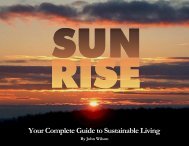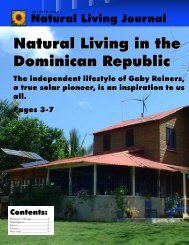Volume 3 - Program & Project Ideas (PDF - 4.5 - Natural Life Network
Volume 3 - Program & Project Ideas (PDF - 4.5 - Natural Life Network
Volume 3 - Program & Project Ideas (PDF - 4.5 - Natural Life Network
Create successful ePaper yourself
Turn your PDF publications into a flip-book with our unique Google optimized e-Paper software.
<strong>Natural</strong> Resources Canada – Community Energy Systems<br />
Source: ACT grant fact sheet. http://www.actprogram.com/english/projects/c10.asp For<br />
additional information, contact Martin B. Silver, General Manager, Region of York Housing<br />
Authority Tel: (905) 895-3223 ext. 2014; Fax: (905) 895-5724. E-mail: ryhc@planeteer.com<br />
- Case study: Charlesbourg, QC<br />
The City of Charlesbourg developed regulations and invited applications to add a second<br />
unit onto an existing bungalow. A demonstration unit was built.<br />
• Efficient use is made of existing infrastructure.<br />
• Urban sprawl is curbed.<br />
• Vehicle between suburbs and city center is reduced.<br />
• Affordable housing is provided.<br />
• Over 80 units have been added to date.<br />
For additional information, contact Peter Murphy, Ville de Charlesbourg, Québec. Tel.: (418)<br />
624-7507, fax: (418) 624-7525.<br />
L.1.9.6 Development cost charges<br />
- Case study: Maple Ridge, BC<br />
Development costs charges (DCC’s) are applied by municipalities to new developments<br />
to offset the costs of additional expenses associated with the development (such as roads<br />
and schools). There are various ways of calculating the DCC’s charged to developers (or<br />
builders). The most common practice is to charge a flat fee or per unit rate, regardless of<br />
the size of the house. The Urban Development Institute: Pacific Region developed a<br />
square foot model for charging DCC’s and consulted with municipalities in Greater<br />
Vancouver Regional District.<br />
Other issues:<br />
• Charging DCC’s on a square footage basis encourages builders to build<br />
smaller houses. Smaller houses use less energy to maintain and build.<br />
• Studies indicate there is also less car ownership among residents of smaller<br />
houses.<br />
• In most cases, smaller houses are on smaller lots, generate less storm water<br />
runoff, and demand less transportation infrastructure.<br />
• Additional DCC’s for secondary suites should be avoided because this<br />
discourages the building of houses with suites.<br />
• DCC’s should reflect the true costs of different types of development. DCC’s<br />
should be lower for moderate density mixed-use areas located in central<br />
locations, and higher for distant low-density single use areas.<br />
Draft 4/11/2005 46






